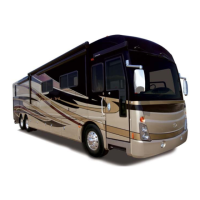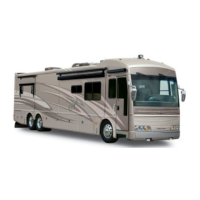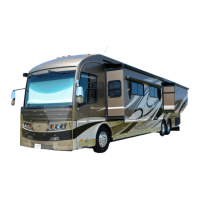Do you have a question about the Fleetwood American Heritage and is the answer not in the manual?
Follow a consistent schedule of inspection and maintenance for your motor home for safety and comfort.
Ensure a pleasurable experience with thorough trip planning and RV knowledge.
Contains valuable documents, including this manual and chassis operator's manual.
Identifies vehicle and components using VIN and Fleetwood Identification Numbers.
Factory alignment is done; owner responsible for post-load adjustments.
Fleetwood does not sanction non-approved devices; may void chassis warranty.
Covers vehicle crash, handling, response, towing, alterations, and warning devices.
Information on vehicle event data recording capabilities for equipped systems.
Details warranty coverage for structure, appliances, and manufacturer-installed equipment.
Excludes automotive chassis, tires, abuse, neglect, environmental conditions, and normal wear.
Dealer must maintain RV prior to sale and correct defects.
Owner must perform normal maintenance and contact dealer for warranty service.
Manufacturer will repair or replace parts upon notice of unresolved claims.
Procedure for obtaining warranty service, including contacting dealer and owner relations.
Information on reporting vehicle defects to NHTSA and Fleetwood Coach Service.
Locates electrical circuit breaker panels, fuse panels, and battery disconnect switches.
Details the 7-position connector for towed vehicle electrical connections.
Overview of driver controls including the VIP Modular RV SmartWheel.
Identification and description of various instrument panel gauges and switches.
Locates electrical panels and battery disconnect switches for Heritage models.
Details the 7-position connector for towed vehicle electrical connections.
Overview of driver controls, including instrument panels and shifter selector.
Identification and description of various instrument panel gauges and switches.
Guidance on proper loading, weight definitions, and capacity limits.
Information on towing limits, hitch ratings, dinghy towing, and weight factors.
Procedures for weighing the motor home to ensure compliance with weight limits.
Covers tire inflation, maintenance, checking pressure, and handling flat tires.
Details seat belt usage, child restraints, and airbag system information.
Guidance on motor home handling, braking, maneuvering, and engine use.
Information on navigation, rearview cameras, and trip computer systems.
Covers fuel systems, exhaust heat, engine temperature, and carbon monoxide safety.
Guidelines and information required for emergency towing of the motor home.
Proper use and maintenance of the windshield wiper and washer system.
Controls and instructions for operating the vehicle leveling system.
Operation and safety for power entry steps and manual/hydraulic stepwell covers.
Details on the operation and security of the main entry and screen doors.
Information on window operation, pull shades, day/night shades, and mini-blinds.
Instructions for operating emergency exit windows for escape routes.
Guidance on storage, furnishings, slide-outs, conversions, lighting, and vents.
Checking holding tank and propane tank levels using the monitor panel.
Managing humidity and preventing mold growth through ventilation and care.
Essential safety practices to prevent and respond to fires in the motor home.
Testing, maintenance, and operation of the battery-powered smoke detector/alarm.
Connecting to city water, filling the on-board water tank, and system checks.
Operation of the water pump and maintenance of the water filter.
Procedure for sanitizing the water tank and piping system using chlorine.
Description of gray and black water tanks, plumbing, and disposal methods.
Guidelines for holding tank care, draining procedures, and tank flush systems.
Considerations for using holding tanks in cold weather to prevent freezing.
Components and functions of the vehicle's 12-volt electrical system.
Details on the 12-volt DC power for interior lights, outlets, and accessories.
Operation of battery disconnect systems and battery inspection/care.
Information on how chassis and house batteries are charged.
Functionality and limitations of the optional solar charging panel.
How to use the auxiliary start system to start the chassis engine or generator.
Overview of the 120-volt AC system including generator, shore cord, and inverter.
Function of the power converter in supplying and charging the electrical systems.
Purpose and testing of GFCI outlets for electrical shock protection.
Starting, stopping, and fuel supply for the generator.
Essential safety guidelines for generator operation and maintenance.
Operation of the AGS for automatic generator start based on battery voltage or AC requests.
Location and purpose of fuse panels and circuit breakers for electrical protection.
Essential safety rules for handling, lighting, and using propane.
Information on propane system performance at low temperatures and BTU availability.
Procedure and warnings for filling the motor home's propane storage tank.
Location, testing, and function of the permanently installed propane leak detector.
Operation of the water heater and its bypass valve for winterizing.
Guidelines for operating the refrigerator, ensuring it is level and considering heat.
Information on the propane-fueled furnace, thermostat, and air flow requirements.
Details on the on-demand heating system providing hot water and interior heat.
Operation of propane range, burners, and exhaust hood, including safety warnings.
Operation of the roof-mounted air conditioner and heat strip, including filter checks.
Information on operating entertainment systems on 120-volt AC power.
Operation of LCD televisions, noting power source and mobile use restrictions.
Function of the surge protection unit for the 120-volt AC power source.
Information on the roof-mounted antenna for VHF and UHF television signals.
Operation and securing of the roof-mounted satellite dish antenna.
Location of telephone jacks for external connections.
Operation and power requirements for the microwave oven.
General advice for maintaining the exterior finish to prevent weathering effects.
Guidelines for cleaning and protecting pressure-sensitive exterior graphics.
Maintenance for moving parts, hinges, latches, and cleaning screens.
Procedures for cleaning and caring for the fiberglass roof material.
Procedures to maintain weatherproof integrity by inspecting and resealing areas.
Care instructions for interior fabrics, countertops, walls, and ceilings.
Accessing the engine and consulting dealer for exterior sealant information.
Consulting dealer for information on oil, fuel pump, and element fuel filters.
Maintaining the windshield wiper and washer system with proper solution.
Overview of maintenance schedules, modified by usage and climate conditions.
Steps to prepare the motor home for short-term storage.
Detailed procedures for preparing the motor home for extended storage periods.
Steps to winterize the motor home, including propane system and appliances.
Complete instructions for winterizing the fresh and waste water systems.
Procedure to inspect and prepare the motor home after a period of storage.
Changes 12-volt DC to 120-volt AC for appliances.
Operating and maintenance manual supplied by the chassis manufacturer.
Maximum permissible loaded weight a specific axle can carry.
Maximum allowable loaded weight of the motor home with towed vehicle.
Maximum permissible weight of the fully loaded motor home.
Maximum allowable weight of a towed trailer or vehicle.
| Category | Motorhomes |
|---|---|
| Model | American Heritage |
| Fresh Water Capacity | 100 gallons |
| Gray Water Capacity | 60 gallons |
| Black Water Capacity | 40 gallons |
| Manufacturer | Fleetwood |
| Width | 102 inches |
| Engine | Cummins Diesel |
| Transmission | Automatic |
| Slide Outs | 2 |












